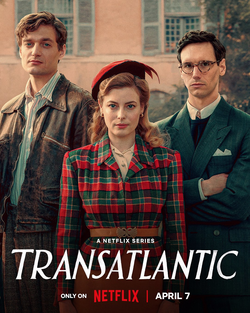APRIL 15, 2023 – I’m amazed by what people do. I speak here not of the bad stuff, though granted, we do a lot of that too. No, I refer here to the extraordinary feats of creative, curious and determined minds that produce works of wonder. My astonishment exceeds ever so slightly my ignorance of those works—if I were wholly ignorant, I’d have no basis for amazement.
The latest work to trigger this reaction was the short Netflix series, Transatlantic. Filmed entirely on location in Marseilles and environs, it depicts the courageous efforts of the Emergency Rescue Committee to facilitate the escape of over 2,500 refugees fleeing the Nazis. Led by the young, Harvard-educated journalist, Vivian Fry, the organization was funded by another young American, a Bohemian heiress from Chicago, Mary Jayne Gold—until her disapproving father abruptly shut off the spigot.
Based on Julie Orringer’s novel, The Flight Portfolio, which, in turn is based on a true story, the Netflix series is smartly produced by Anna Winger, an American expat in Berlin, and Camille McCurry, superbly directed by a collaborative team. Script, acting, direction, costuming, set design, cinematography are excellent.
What’s most remarkable about Transatlantic, however, is the story; the tale of some of the greatest thinkers, writers, artists of the day, most of them Jewish, who were chased by the Nazis from Berlin, then occupied Paris and fascist collaborators in Vichy France and ultimately, by the Nazis’ lackey French police in Marseilles. The timeframe is 1940-41, before the United States entered the war. Leveraging his country’s neutrality, Mr. Fry plied the local American Consulate office for its reluctant assistance. When Ms. Gold’s underwriting of the project dried up, she resorted to helping British intelligence operatives in exchange for funding—unbeknownst to Fry and much to his chagrin, when he learned of the dicey move, which he feared would jeopardize the mission of the ERC.
Artistic license is taken with several principal characters—the unscrupulous and anti-Semitic consul, Graham Patterson, for example, is a composite figure; Thomas Lovegrave, whose mansion houses the refugees while they await their visas, and who portrays Fry’s lover and Gold’s accomplice, is fictional, along with two “Colonials,” brothers who serve behind the desk at the Hotel Splendide, and help Fry behind the scenes—until the place is raided top to bottom by the police. But many of the characters besides Fry and Gold were real and credibly cast: political philosopher Hannah Arendt; philosopher, cultural critic and essayist Walter Benjamin (and Lisa Flittko, who helped Benjamin and other refugees escape and wrote two memoirs after the war); artists Marc Chagall, Marcel Duchamp, Victor Brauner, Hans Bellmer and Jacqueline Lambda; heiress and art collector Peggy Guggenheim; writer and poet André Breton (married to Jacqueline Lambda); satirical author Walter Mehring; Russian revolutionist, novelist, poet Victor Serge; economist and resistance fighter Otto Albert Hirschman; Hiram Bingham IV, Vice Consul in Marseilles who defied his boss (and the American State Department) by surreptitiously aiding Fry’s efforts by churning out forged American visas.
Enthralled by the story and the series, I was not closely familiar with the featured artists, writers and thinkers. Marc Chagall, Max Ernst and Peggy Guggenheim, perhaps, but the others? Barely, hardly or not at all. And the brave people who risked personal safety, material well-being and even prosecution for treason (!) to save the lives of others; people like Fry, Gold and Bingham? The names had never appeared on my radar. Yet here this lively set of characters were brought to life and in highly entertaining ways that were a throwback to happier times.
But this is merely background . . . (Cont.)
(Remember to subscribe to this blog and receive notifications of new posts by email.)
© 2023 by Eric Nilsson
